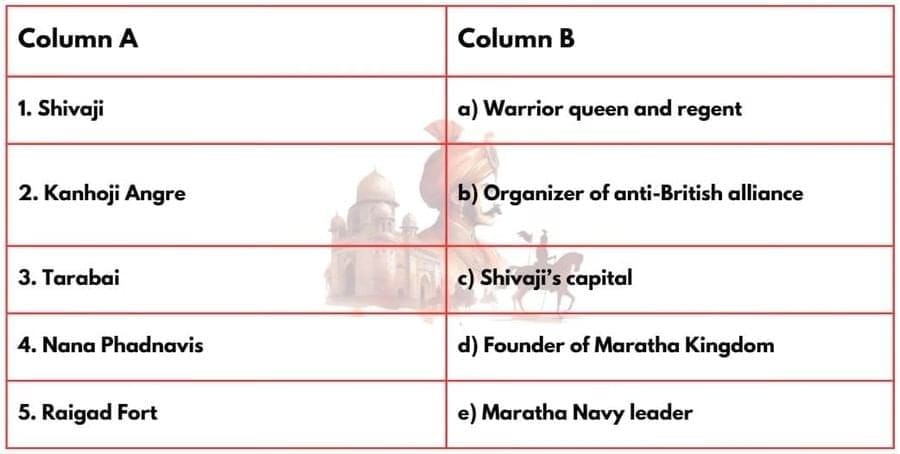Worksheet: The Rise of the Marathas | Worksheets with Solutions for Class 8 PDF Download
| Table of contents |

|
| Multiple Choice Questions (MCQs) |

|
| Match the Following |

|
| True or False |

|
| Fill in the Blanks |

|
| Very Short Question Answers |

|
Multiple Choice Questions (MCQs)
Q1. The Marathas primarily hail from which region?
(a) Punjab
(b) Maharashtra
(c) Gujarat
(d) Rajasthan
Q2. The Maratha leader who founded the kingdom and envisioned Swarajya was—
(a) Sambhaji
(b) Tarabai
(c) Shivaji
(d) Bajirao I
Q3. Which military tactic was Shivaji famous for?
(a) Large-scale infantry battles
(b) Naval warfare only
(c) Guerrilla warfare
(d) Siege warfare only
Q4. The council of ministers established by Shivaji was known as—
(a) Peshwa
(b) Ashta Pradhana Mandala
(c) Diwan
(d) Mansabdari
Q5. The Maratha tax called ‘chauth’ was approximately—
(a) 10%
(b) 15%
(c) 25%
(d) 50%
Q6. Who led the Maratha Navy in the 18th century, earning a reputation as a formidable admiral?
(a) Kanhoji Angre
(b) Sambhaji
(c) Mahadji Shinde
(d) Nana Phadnavis
Q7. Which queen led Maratha resistance after Rajaram’s death?
(a) Ahilyabai Holkar
(b) Tarabai
(c) Jijabai
(d) Rani Durgavati
Q8. The capital fort of Shivaji’s kingdom was—
(a) Daulatabad
(b) Raigad
(c) Purandar
(d) Pratapgad
Q9. Which Maratha ruler is credited for organizing the first pan-Indian anti-British alliance?
(a) Nana Phadnavis
(b) Bajirao I
(c) Mahadji Shinde
(d) Peshwa Balaji Bajirao
Q10. The script primarily used by Marathas for correspondence was—
(a) Devanagari
(b) Modi
(c) Persian
(d) Kannada
Match the Following

True or False
Q1. Shivaji abolished hereditary posts and paid officials salaries.
Q2. The Maratha army included only infantry and cavalry, no navy.
Q3. Chauth was a tax levied only on territories directly ruled by Marathas.
Q4. Ahilyabai Holkar was known for charitable works and temple restoration.
Q5. The Marathas had modern ships that matched European technology.
Q6. Trade and infrastructure development were supported under Maratha rule.
Fill in the Blanks
Q1. The Maratha movement for self-rule is called ________.
Q2. Shivaji’s council of eight ministers was called ________.
Q3. The tax called ‘chauth’ amounted to ________ percent of revenue.
Q4. The famous Maratha naval commander was ________.
Q5. The fort at which Shivaji was crowned is called ________.
Q6. The script used for Maratha official correspondence was called ________.
Q7. The leader credited with uniting Indian powers against the British was ________.
Very Short Question Answers
Q1. Who was Shivaji and why is he important?
Q2. What was guerrilla warfare used by the Marathas?
Q3. What was the ‘chauth’ tax?
Q4. How did the Marathas challenge European naval power?
Q5. Name two cultural contributions of the Marathas.
Q6. Who was Tarabai and what was her role?
Q7. Describe the Maratha administrative system under Shivaji.
Q8. What was Nana Phadnavis known for?
Q9. How did Marathas support trade and infrastructure?
Q10. How did forts help the Marathas?
FAQs on Worksheet: The Rise of the Marathas - Worksheets with Solutions for Class 8
| 1. What were the key factors that contributed to the rise of the Marathas? |  |
| 2. Who was Chhatrapati Shivaji Maharaj, and what was his significance in Maratha history? |  |
| 3. How did the Marathas manage to establish their rule over a vast territory? |  |
| 4. What were the major battles fought by the Marathas during their rise? |  |
| 5. How did the rise of the Marathas impact the socio-political landscape of India? |  |




















